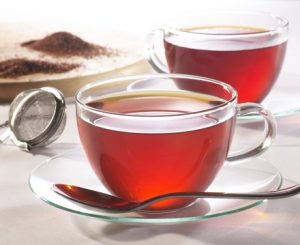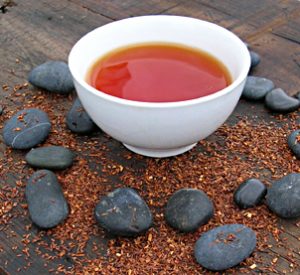Rooibos is a herbal tea made from the leaves of a South African plant known botanically as Aspalathus linearis. Rooibos (pronounced roy-boss) is the Afrikaaner name meaning “red bush”. It’s a small shrub in the legume family with needle-like leaves that grows naturally in Western Cape and is now cultivated commercially.
 Rooibos has a long history of traditional use by the Hottentots and Bushmen, who left the leaves outside to ferment after pounding them with wooden hammers. Early European settlers and explorers noted that the local people drank large quantities of Rooibos as a tea. The tea was used as a refreshing drink, for diarrhoea and for various digestive complaints.
Rooibos has a long history of traditional use by the Hottentots and Bushmen, who left the leaves outside to ferment after pounding them with wooden hammers. Early European settlers and explorers noted that the local people drank large quantities of Rooibos as a tea. The tea was used as a refreshing drink, for diarrhoea and for various digestive complaints.
By the late 1920s, Rooibos was being used by Europeans, and during World War ІІ, when it was difficult to get regular tea, Rooibos was introduced as a substitute. The leaves, shoots and twigs are used in modern commercial production and these parts of the plant contain a red pigment. After bruising, cutting and fermenting, the plant develops a brick colour and reputedly becomes aromatic.
Constituents
• Rooibos is rich in flavonoids and Vitamin C, although processing storage and heat deplete water-soluble vitamins. The flavonoids, in particular, are powerful antioxidants, some of which are known to prevent damage to the body’s skin cells. Flavonoids in general also protect the linings of the body, including blood vessel walls and cell membranes.
• Rooibos does not contain caffeine or stimulating compounds. Most people find it settles the nerves without causing drowsiness.
• The plant contains 1 – 3 percent tannin, which would account for its folk use for diarrhoea. Some categories of tannins are antioxidants and others strengthen and tone internal tissue in the body. Tannins in general can be irritating and drying if consumed in very large quantities, but Rooibos contains less tannin than common tea.
• In an experiment using cells, a polysaccharide isolated from Rooibos showed anti-HIV activity. This doesn’t mean it’s a treatment, but it could be beneficial for affected people to drink the tea daily.
Therapeutic Activity
 • A human study confirms that, compared with ordinary tea, Rooibos barely affects iron absorption.
• A human study confirms that, compared with ordinary tea, Rooibos barely affects iron absorption.
• X-ray (radiation) damage was reduced when mice were given Rooibos extract. (Cancer letters, 77; 33-8: 1994). In my clinic, I see a number of people who are worried about having x-rays and scans and I am now recommending they take Rooibos tea for at least a few days before and after the procedure. Various flavonoids can protect against radiation damage and this is thought to be due to their free radical scavenging potency.
• Rooibos tea and extract has anti-mutagenic properties, confirmed in a number of studies. This means Rooibos may have the capacity to prevent cell damage by mutagens. Rooibos tea and other flavonoid-rich foods may also help prevent chromosome/genetic damage.
• In animal studies, Rooibos tea helped the growth of primary cells, fibroblasts and muscle cells, thought to be due to the antioxidant and scavenging effect of the tea.
• A study published in the “South Africa Medical Journal” in 1982 found Rooibos tea helped soothe some types of allergic reaction and it has a reputation for alleviating dermatitis. Some people find it soothes the skin when dabbed on or used in a bath. One way of applying Rooibos to the skin would be to make an infusion with just enough water to cover the tea, then cover and allow to cool. Add some of the brew to a small quantity of aqueous cream, which you can buy from any pharmacy. I suggest making up a small quantity of tea at a time because it doesn’t contain any preservatives and even in the fridge may degrade after a few days. Particularly if you have a sensitive skin, always do a little test patch on the skin inside your elbow before using any new remedy. Some researchers suggest the processing into tea reduces the anti-mutagenic and antioxidant properties of Rooibos; no doubt extracts will soon be available.
 Toxicity
Toxicity
There are no reports of toxicity, which is reinforced by the historical use of large quantities.
Dose
I recommend 1 – 3 cups daily.

